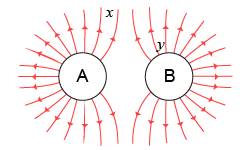|
A force field diagram is a tool for visualizing the electric forces around charged objects. The electric field is a vector that represents the force on a positive test charge. By convention, the electric field points in the direction of the electrostatic force on a positive test charge. Because of this, electric field lines point away from positive source charges and toward negative ones. The strength of the electric field (in newtons per coulomb, or N/C) is the force felt by a charged particle divided by the particle’s electric charge. The closer the field lines are to each other, the stronger is the force. 
|
|
electric field, electric field lines
|
|
|
|
Review problems and questions |
|

- An atom consists of a positively charged nucleus surrounded by one or more negatively charged electrons, which occupy a region of space known as the electron cloud.
- Which of the diagrams depicts the electric field generated by the nucleus?
- Which diagram correctly shows the directions of electric forces on the electrons?
- Did you choose the same diagram for the previous two questions? Why or why not?


|
- Diagram (i) correctly depicts the electric field surrounding the nucleus. This is because electric field lines always point away from a positive charge, and they always represent the net electrostatic force upon an imaginary positive test charge.
- Diagram (ii) correctly depicts the directions of the forces that the nucleus exerts upon electrons. That’s because electrons are negatively charged, and they are attracted to the positive nucleus.
- No. The net electrostatic force upon a negatively charged particle will always be in the direction opposite to the electric field vectors.

|
- A commonly encountered unit of charge in consumer electronics is the milliamp-hour, or mAh, and in the USA the pound, or lb, is a commonly used unit of force. How many newtons per coulomb (N/C) would be equivalent to 1 lb/mAh?


|
1 lb/mAh = 1.2 N/C. You can work out the conversion factor as follows: 
|
- Rebecca inflates a rubber party balloon, ties it to a string, and hangs it from the ceiling. Then she rubs the balloon with a wool sweater. Suppose that she transfers one trillion “extra” electrons (1012 e−) to the balloon. Assume, too, that you can pretend that all of this excess charge is located at the center of the balloon. What is the electric field strength 1 m from the center of the balloon?


|
Answer: The field strength is −1,440 N/C.
Asked: electric field strength E
Given: number of excess electrons = 1012; distance from charge, r = 1 m
Relationship: electric field around a point charge, E = keq/r2
Solution: The solution requires us to multiply the number of electrons by the charge on one electron to obtain the total net charge of the balloon: The minus sign indicates that a positive test charge lying outside of the balloon would be drawn toward the balloon and therefore that the electric field points inward toward the balloon. Keep in mind that, while a trillion sounds like a lot of electrons, it only adds up to a negative charge of 1.6×10−7 C, or 160 billionths of a coulomb; and one-trillion electrons could be taken from just 1.7 trillionths of one mole of hydrogen atoms. 
|

- Declare each of the following statements as true or false, based upon the accompanying electric field diagram.
- Object A is positively charged.
- Objects A and B have opposite charges.
- The electric field at point x is stronger than that at point y.


|
- True. Electric field lines, by convention, point away from positive charges.
- False. The field lines also point away from Object B, indicating that it is positive. Notice also that the field lines from Object A seem to push against those from Object B, and this is what happens when two like charges are brought close together.
- False. The closer field lines are to one another, the stronger the electric field is.

|
Take a Quiz |

